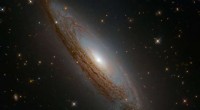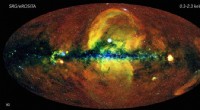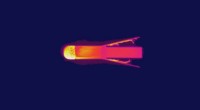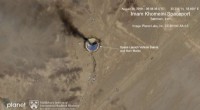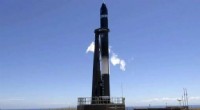
Wetenschap
We konden buitenaardse beschavingen detecteren via hun interstellaire kwantumcommunicatie
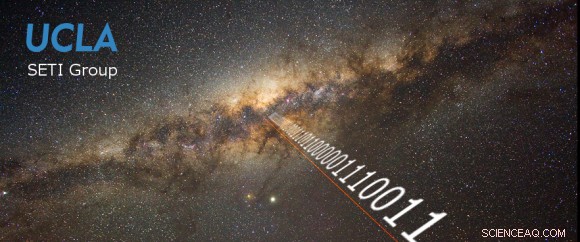
Foto van de centrale regio van de Melkweg. Krediet:UCLA SETI Groep/Yuri Beletsky, Carnegie Las Campanas-observatorium
Sinds het midden van de 20e eeuw, wetenschappers hebben gezocht naar bewijs van intelligent leven buiten ons zonnestelsel. Een groot deel van die tijd, wetenschappers die zich bezighouden met het zoeken naar buitenaardse intelligentie (SETI) hebben vertrouwd op radioastronomie-onderzoeken om te zoeken naar tekenen van technologische activiteit (ook bekend als "technosignatures"). Met 4, 375 exoplaneten bevestigden (en er worden nog meer!) verwacht dat er in de nabije toekomst nog grotere inspanningen zullen plaatsvinden.
Vooruitlopend op deze inspanningen, onderzoekers hebben andere mogelijke technosignaturen overwogen waar we op moeten letten. Volgens Michael Hippke, een gastonderzoeker aan het UC Berkeley SETI Research Center, de zoekopdracht moet ook worden uitgebreid met kwantumcommunicatie. In een tijd waarin kwantumcomputing en aanverwante technologieën hun voltooiing naderen, het is logisch om ergens anders naar tekenen van hen te zoeken.
De zoektocht naar technosignaturen, en wat de meest veelbelovende zijn, staat de laatste jaren opnieuw in de belangstelling. Dit is grotendeels te danken aan het feit dat duizenden exoplaneten beschikbaar zijn voor vervolgonderzoek met behulp van de volgende generatie telescopen die de komende jaren operationeel zullen zijn. Met deze instrumenten op zoek naar spelden in de "kosmische hooiberg, "astrobiologen moeten duidelijk hebben waar ze op moeten letten.
In september 2018, NASA organiseerde een Technosignatures Workshop, die werd gevolgd door de release van hun Technosignature Report. Tegen augustus 2020, NASA en het Blue Marble Institute sponsorden een andere bijeenkomst - Technoclimes 2020 - om concepten te bespreken voor toekomstige zoekopdrachten die verder zouden gaan dan de gebruikelijke radiosignalen naar technosignaturen. Als iemand die zijn professionele leven aan SETI heeft gewijd, Hippke heeft veel inzichten te bieden.
De zoektocht tot nu toe
Zoals hij in zijn studie opmerkte, moderne SETI-inspanningen begonnen in 1959 toen de beroemde SETI-pionier Giuseppe Cocconi &natuurkundige Philip Morrison (beiden van de Cornell University destijds) hun baanbrekende artikel publiceerden, "Zoeken naar interstellaire communicatie." In deze krant, Coccini en Morrison adviseerden om te zoeken naar tekenen van intelligent leven door te zoeken naar smalbandige signalen in het radiospectrum.
Dit werd twee jaar later gevolgd door R.N. Schwartz en C.H. Townes van het Institute of Defense Analyses (IDA) in Washington D.C. In hun paper, "Interstellaire en interplanetaire communicatie door optische masers, "Ze stelden voor dat optische pulsen van microgolflasers een indicatie kunnen zijn van buitenaardse intelligentie (ETI) die berichten de kosmos in stuurt.
Maar zoals Hippke opmerkt, zes decennia en meer dan honderd toegewijde zoekprogramma's later, enquêtes die naar deze specifieke technosignaturen hebben gezocht, hebben niets concreets opgeleverd. Dit wil niet zeggen dat de wetenschappers tot nu toe naar de verkeerde handtekeningen hebben gezocht, maar dat het nuttig zou kunnen zijn om te overwegen een breder net uit te werpen. Zoals Hippke in zijn paper uitlegde:
"We zijn op zoek (en moeten blijven zoeken) naar smalbandige vuurtorenontploffingen, ook al hebben we er nog geen gevonden. Tegelijkertijd, het is mogelijk om onze zoektocht uit te breiden... In de gangen van astronomie-afdelingen wordt soms beweerd dat we 'gewoon op de juiste band moeten afstemmen' en - voilà - zullen worden aangesloten op het galactische communicatiekanaal."
Een kwantumrevolutie
Hoewel vrijwel alle pogingen om kwantumprocessors te maken relatief recent zijn (sinds de eeuwwisseling), het concept zelf dateert uit de vroege jaren 1970. Het was in deze tijd dat Stephen Weisner, een hoogleraar natuurkunde aan de Columbia University destijds, voorgesteld dat informatie veilig kan worden gecodeerd door gebruik te maken van het principe van superpositie.
Dit principe stelt de "spin" van een elektron, een fundamentele eigenschap die "omhoog" of "omlaag kan worden georiënteerd, " is onbepaald - wat betekent dat het een of beide tegelijk kan zijn. Dus terwijl een opwaartse of neerwaartse spin vergelijkbaar is met de nullen en enen van binaire code, het superpositieprincipe houdt in dat kwantumcomputers op elk moment een exponentieel groter aantal berekeningen kunnen uitvoeren.
Naast de mogelijkheid om meer functies uit te voeren, Hippke identificeert vier mogelijke redenen waarom een ETI zou kiezen voor kwantumcommunicatie. Deze omvatten "poortwachters, "kwantum suprematie, informatiebeveiliging, en informatie-efficiëntie. "Ze hebben de voorkeur boven klassieke communicatie met betrekking tot beveiliging en informatie-efficiëntie, en ze zouden bij alle eerdere zoekopdrachten aan detectie zijn ontsnapt, " hij schrijft."
Het gebruik van computers is de afgelopen eeuw sterk geëvolueerd, van geïsoleerde machines tot het wereldwijde web, en mogelijk in de toekomst tot een interplanetair netwerk. Kijkend naar de toekomst, Hippke stelt dat het niet vergezocht is om te geloven dat de mensheid kan gaan vertrouwen op een interstellair kwantumnetwerk dat gedistribueerde kwantumcomputers en de overdracht van qubits over lange afstanden mogelijk maakt.
Gebaseerd op de veronderstelling dat de mensheid geen uitbijter is, maar representatief voor de norm (ook bekend als het Copernicaanse principe) is het logisch om aan te nemen dat een geavanceerd ETI al zo'n netwerk zou hebben gecreëerd. Gebaseerd op menselijk onderzoek naar kwantumcommunicatie, Hippke vier mogelijke methoden. De eerste is "polarisatiecodering, " die vertrouwt op de horizontale en verticale polarisatie van licht om gegevens weer te geven.
De tweede methode omvat de "Fock-toestand" van fotonen, waarbij een signaal wordt gecodeerd door af te wisselen tussen een discreet aantal deeltjes en vacuüm (vergelijkbaar met binaire code). De twee overblijvende opties omvatten ofwel time-bin-codering - waarbij vroege en late aankomst wordt gebruikt - of coherente codering van de toestand van licht, waar licht in amplitude wordt geperst of in fase wordt geperst om een binaire code te simuleren.
Veiligheid en suprematie
Van de vele voordelen die kwantumcommunicatie zou bieden voor een technologisch geavanceerde soort, Gate-Keeping is vooral interessant vanwege de implicaties die het kan hebben voor SETI. Ten slotte, het verschil tussen wat we aannemen is de statistische waarschijnlijkheid van intelligent leven in ons heelal en het gebrek aan bewijs daarvoor (ook bekend als de Fermi-paradox) schreeuwt om verklaringen. Zoals Hippke het zegt:
"ETI kan er bewust voor kiezen om communicatie onzichtbaar te maken voor minder geavanceerde beschavingen. Misschien voelen de meeste of alle geavanceerde beschavingen de behoefte om de "apen" uit het galactische kanaal te houden, en laat leden alleen deelnemen boven een bepaald technologisch minimum. Het beheersen van kwantumcommunicatie kan deze limiet weerspiegelen."
Het idee van kwantumcommunicatie werd voor het eerst bepleit door Mieczyslaw Subotowicz, een professor in astrofysica aan de Maria Curie-Sklodowska Universiteit in Lublin (Polen), in 1979. In a paper titled "Interstellar communication by neutrino beams, " Subotowicz argued that the difficulties this method presented would be a selling point to a sufficiently advanced extraterrestrial civilization (ETC).
By opting for a means of communication that has such a small cross-section, an ETC would only be able to communicate with similarly advanced species. Echter, Hippke noted, this also makes it virtually impossible to detect entangled pairs of neutrinos. Om deze reden, entangled photons would not only provide for gate-keeping, but they would also be detectable by those meant to receive them.
evenzo, quantum communication is also preferable because of the security it allows for, which is one of the main reasons the technology is being developed here on Earth. Quantum key distribution (QKD) enables two parties to produce a shared key that can be used to encrypt and decrypt secret messages. In theorie, this will lead to a new era where encrypted communications and databases are immune to conventional cyber attacks.
In aanvulling, QKD has the unique advantage of letting the two parties detect a potential third party attempting to intercept their messages. Based on quantum mechanics, any attempt to measure a quantum system will collapse the wave function of any entangled particles. This will produce detectable anomalies in the system, which would immediately send up red flags. Said Hippke:
"We do not know whether ETI values secure interstellar communication, but it is certainly a beneficial tool for expansive civilizations which consist of actions, like humanity today. Daarom, it is plausible that future humans (or ETI) have a desire to implement a secure interstellar network."
Another major advantage to quantum computing is its ability to solve problems exponentially faster than its digital counterparts—what is known as "quantum supremacy." The classic example is Shor's algorithm, a polynomial-time quantum algorithm for factoring integers that a conventional computer would take years to solve, but a quantum computer could crack in mere seconds.
In traditional computing, public-key encryption (such as the RSA-2048 encryption) employs mathematical functions that are very difficult and time-consuming to compute. Given that they can accommodate an exponentially greater number of functions, it is estimated that a quantum computer could crack the same encryption in about ten seconds.
Laatste, maar niet de minste, there's the greater photon information efficiency (PIE) that quantum communications offer over classical channels—measured in bits per photon. According to Hippke, quantum communications will improve the bits per photon efficiency rating by up to one-third. In this regard, the desire for more efficient data transmissions will make the adoption of a quantum network something of an inevitability.
"Turned the other way around, classical channels are energetically wasteful, because they do not use all information encoding options per photon, " he writes. "A quantum advantage of order 1/3 does not seem like much, but why waste it? It is logical to assume that ETI prefers to transmit more information rather than less, per unit energy."
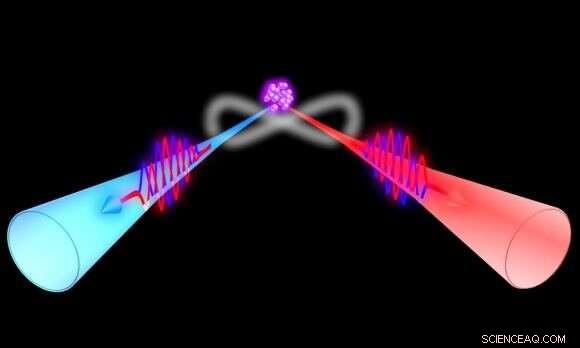
Quantum entanglement visualized. Credit:Physics Department, HKUST
Challenges
Natuurlijk, no SETI-related pitch would be complete without mentioning the possible challenges. Voor starters, there's the matter of decoherence, where energy (and hence, information) is lost to the background environment. Where transmissions through interstellar space are concerned, the main issues are distance, free electrons (solar wind), interplanetary dust, and the interstellar medium—low-density clouds of dust and gas.
"As a baseline, the largest distance over which successful optical entanglement experiments have been performed on Earth is 144 km, " notes Hippke. Since the mass density of the Earth's atmosphere is 1.2 kg m -3 , this means that a signal passing through a column 144 km (~90 mi) in length was dealing with a column density of 1.728×10 5 kg m -2 . In tegenstelling tot, the column density between Earth and the nearest star (Proxima Centauri) is eight orders of magnitude lower (3×10 -8 kg m -2 ).
Another issue is the delay imposed by a relativistic Universe, which means that messages to even the closest star systems would take years. Als resultaat, quantum computation is something that will be performed locally for the most part, and only condensed qubits will be transmitted between communication nodes. Met dit in gedachten, there are a few indications humanity could be on the lookout for in the coming years.
What to Look For?
Depending on the method used to transmit quantum information, certain signatures would result that SETI researchers could identify. Momenteel, SETI facilities that conduct observations in the visible light spectrum are not equipped to receive quantum communications (since the technology does not exist yet). Echter, they are equipped to detect photons, obtain spectra, and perform polarization experiments.
Als zodanig, argues Hippke, they would be able to tease out potential signals from the background noise of space. This is similar to what Professor Lubin suggested in a 2016 paper ("The Search for Directed Intelligence"), where he argued that optical signals (lasers) used for directed-energy propulsion or communications would result in occasional "spillover" that would be detectable.
In much the same way, "errant" photons could be collected by observatories and measured for signs of encoding using various techniques (including the ones identified in the study). One possible method Hippke recommends is long-duration interferometry, where multiple instruments monitor the amplitude and phase of electromagnetic fields in space over time and compare them to a baseline to discern the presence of encoding.
One thing bears consideration though:If by listening in on ETI quantum communications, won't that cause information to be lost? And if so, would the ETI in question not realize we were listening in? Assuming they were not aware of us before, they sure would be after all this went down! One might conclude that it would be better to not eavesdrop on the conversations of more advanced species!
 Moleculaire motor:vier rotatietoestanden
Moleculaire motor:vier rotatietoestanden Nieuwe methode verbetert de productie van biowaterstof en andere biochemicaliën aanzienlijk
Nieuwe methode verbetert de productie van biowaterstof en andere biochemicaliën aanzienlijk Een scanning transmissie-röntgenmicroscoop voor analyse van chemische toestanden van lithium
Een scanning transmissie-röntgenmicroscoop voor analyse van chemische toestanden van lithium Is er leven ontstaan in de oersoep via DNA of RNA? Misschien allebei
Is er leven ontstaan in de oersoep via DNA of RNA? Misschien allebei We weten nu hoe insecten en bacteriën ijs bestrijden
We weten nu hoe insecten en bacteriën ijs bestrijden
 Waarom is ademhaling belangrijk voor organismen?
Waarom is ademhaling belangrijk voor organismen?  Onderzoek toont aan dat Bristol het koolstofneuraal doel voor 2030 niet zal bereiken zonder een grote transporttransformatie
Onderzoek toont aan dat Bristol het koolstofneuraal doel voor 2030 niet zal bereiken zonder een grote transporttransformatie Expeditie haalt tonnen plastic uit afgelegen Hawaï-atollen
Expeditie haalt tonnen plastic uit afgelegen Hawaï-atollen Bodemonderzoek geeft aanwijzingen voor het oude klimaat
Bodemonderzoek geeft aanwijzingen voor het oude klimaat Beving Papoea-Nieuw-Guinea veroorzaakt kleine tsunami, geen schade
Beving Papoea-Nieuw-Guinea veroorzaakt kleine tsunami, geen schade
Hoofdlijnen
- Onderzoek Topic Ideeën voor Biologie
- Nieuw onderzoek lost een van de meest verhitte geschillen over evolutionaire biologie op robuuste wijze op
- Een vogel in de bush is $223 waard, 851 in de hand
- Wat zijn wierook en mirre?
- Routes uit isolatie voor Yellowstone grizzlyberen
- Wat is het verschil tussen een nucleotide en een nucleoside?
- Wat betekent Kaukasisch echt?
- Video van vier bobcats in een buitenwijk toont gezonde populatie
- Reproductie van plantaardige cellen
 Australiërs gevangen door bosbranden verteld te laat om te vertrekken
Australiërs gevangen door bosbranden verteld te laat om te vertrekken Studie onthult eigenschappen van een Type Ib supernova in NGC 4080
Studie onthult eigenschappen van een Type Ib supernova in NGC 4080 Aardbeving helpt de zwartgeblakerde lucht boven de steenovens van Nepal te zuiveren
Aardbeving helpt de zwartgeblakerde lucht boven de steenovens van Nepal te zuiveren Hoe worden rivierrotsen gevormd?
Hoe worden rivierrotsen gevormd?  Digitaal slagveld doemt op voor de verkiezingen van 2020
Digitaal slagveld doemt op voor de verkiezingen van 2020 Herbivore, Omnivore and Carnivore Animals
Herbivore, Omnivore and Carnivore Animals  Studie biedt nieuwe aanwijzingen voor het verbeteren van chemotherapie
Studie biedt nieuwe aanwijzingen voor het verbeteren van chemotherapie Gezichtsherkenning uitvoeren op gebouwen om architecturale geheimen te ontgrendelen
Gezichtsherkenning uitvoeren op gebouwen om architecturale geheimen te ontgrendelen
- Elektronica
- Biologie
- Zonsverduistering
- Wiskunde
- French | Italian | Spanish | Portuguese | Swedish | German | Dutch | Danish | Norway |

-
Wetenschap © https://nl.scienceaq.com

